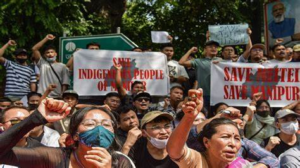
MANIPUR VIOLENCE: ENCROACHMENT OF THE TRIBAL PEOPLE

There have reportedly been clashes between tribal people and Meiteis in Churachandpur, Imphal, and other places. In Manipur, the Meitei ethnic group predominates, and one of the largest tribes is Kuki.
In recent days, ethnic violence in India’s northeastern state of Manipur has caused thousands of people to be displaced as well as numerous deaths and injuries.
The long-brewing conflict was set off by tribal protests against a plan to give the majority Meiteis Scheduled Tribe (ST) status, which the people of the hills had been enjoying for decades.
The Meiteis, who make up around 53% of the state’s population, are the largest ethnic group in the Imphal Valley, while the tribal population, which is primarily made up of Nagas and Kukis, accounts for about 40% of the total and is concentrated in the nearby hills.
The BJP state administration started an eviction campaign in the Churachandpur, Kangpokpi, and Tengnoupal districts in February 2023, branding the forest inhabitants as encroachers, which was perceived as anti-tribal.
At Thomas Ground in the Kangpokpi district, where protesters had gathered to hold a rally against “encroachment of tribal land in the name of reserved forests, protected forests, and wildlife sanctuary,” there was a violent altercation that left five people hurt in March 2023.
The Manipur Cabinet withdrew from the Suspension of Operation ceasefire accords with the Zomi Revolutionary Army and the Kuki National Army in the same month.

ROOT CAUSE OF MANIPUR VIOLENCE:
The Meitei community’s almost ten-year-old desire for a Scheduled Tribe status is at the foundation of the violence’s intensification in Manipur. However, the immediate cause of this violence is a Manipur High Court ruling requiring the state administration to recommend a ST tag for the group to the Union Tribal Affairs Ministry by May 29. Before Manipur and the Indian Union were united, the petitioners claimed that this community had previously benefited from the ST designation. They are now asking for the status to be reinstated.
Thousands of people took part in a “Tribal Solidarity March” organized by a student organization in each of Manipur’s ten hill districts on Wednesday in opposition to the demand that the Meitei community be added to the ST list in response to the Manipur HC ruling.
The eviction drive, which started in February, was perceived as yet another anti-tribal action, alarming and upsetting not only the Kuki community, which it affected, and also the other tribals who have many villages inside protected forest areas.
There is serious tension ashore in Manipur. As populaces expansion in the ancestral towns, they will more often than not spread out into encompassing backwoods regions, which they think about their verifiable and genealogical right. The government disputes this. The Meitei, who live in the valleys, are enraged at the same time because tribal people can buy land in the valleys while they cannot settle or buy land in the hilly areas.
IMPACT OF THE VIOLENCE:
The majority Kuki Tribal population’s homes and churches were strike in the non-tribal areas on May 3rd during the unrest. According to the police, 500 residents of 500 tribal households in Imphal were displaced and forced to seek shelter in Lamphelpat after they were attacked.
A total of 1000 Meiteis who were impacted by the violence had to leave the area and seek refuge in Bishnupur. In Kangpokpi, 20 homes were destroyed by fire. Several homes, places of worship, and other properties were burned down during the violence, which also occurred in Churachandpura, Kakching, Canchipur, Soibam Leikai, Tenugopal, Langol, Kangpokpi, and Moreh.
Since the first insurgency broke out in Manipur in the early 1950s, at least 50,000 people have died in the conflicts.
The Manipur government provided a take shot at sight request on 4 May. Toward the finish of 3 May, 55 sections of the Assam Rifles and the Indian Armed force were sent in the locale and by 4 May, in excess of 9,000 individuals were migrated to more secure areas. Around 20,000 people had been moved to safe locations under military supervision by 5 May, and 23,000 people had been moved by 6 May.
Five Rapid Action Force companies were transported to the region by air by the central government. In Manipur, nearly 10,000 members of the military, paramilitary, and Central Armed Police Forces were stationed. The Union government assumed control of Manipur’s security on May 4 by invoking the Indian constitution’s security provision, Article 355.
A few slopes based assailants drew in with the Indian Save Brigade in which five assailants were killed. Four militants were killed in a separate encounter. During the violence, at least twenty-seven churches were destroyed or burned down.

RESULT OF THE REVOLT:
Given the current pressures in the Express, the High Court request an administration suggestion to concede ST status to Meiteis is being viewed as provocative. Indeed, even among the Meiteis, there is resistance to it. The Meiteis have been a settled agricultural community for more than 2,000 years, according to their history.
CONCLUSION:
However, no one could have foreseen the spiral of violence that would engulf the state, which is frequently referred to as the jewel of the northeast, like a forest fire. Hundreds of people were killed and injured, and thousands of people were forced to flee their homes, prompting the central government to rush in large numbers of the Army, Assam Rifles, and central police forces to contain the situation.
Public outrage over the government’s “extreme disregard” of Scheduled Hill areas and Articles 370 and 371 C of the Constitution, which applied to Manipur, prompted the rallies. The group said that the Chief Minister’s description of the rally participants as “encroachers, poppy cultivators, drug smugglers, and illegal immigrants” was offensive to it.
According to the Scheduled Tribes Demand Committee of Manipur (STDCM), which has been leading the call for the Meiteis to be added to the ST list, the community has been harmed without any protections provided by the Constitution.







